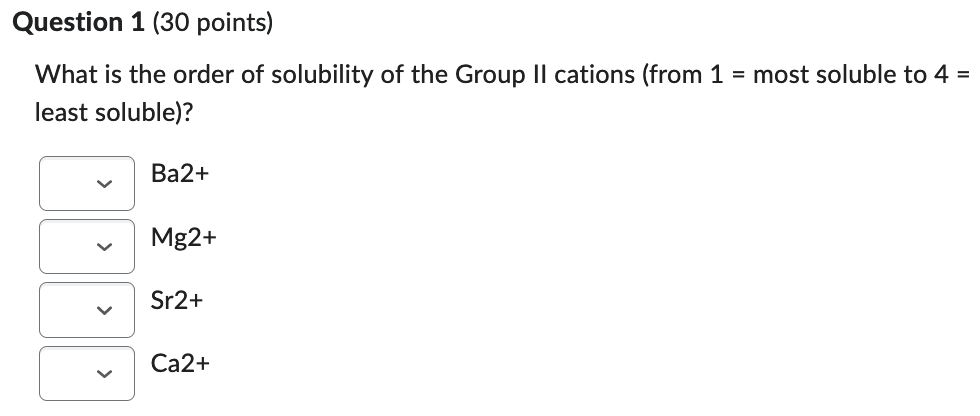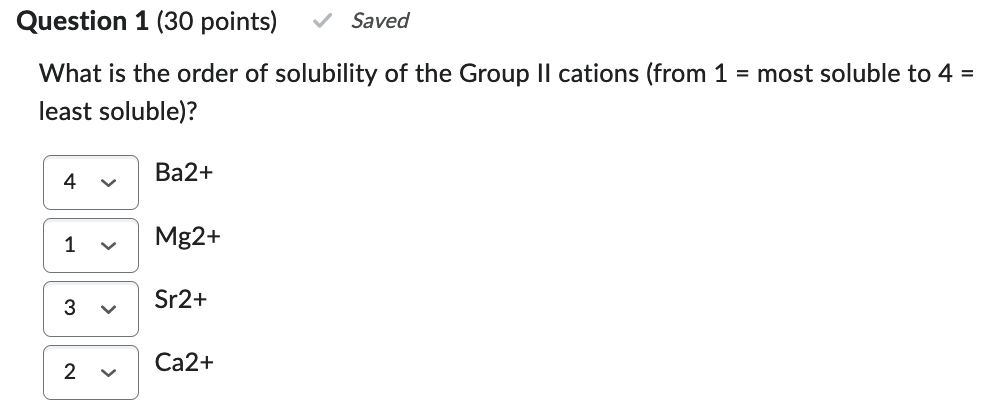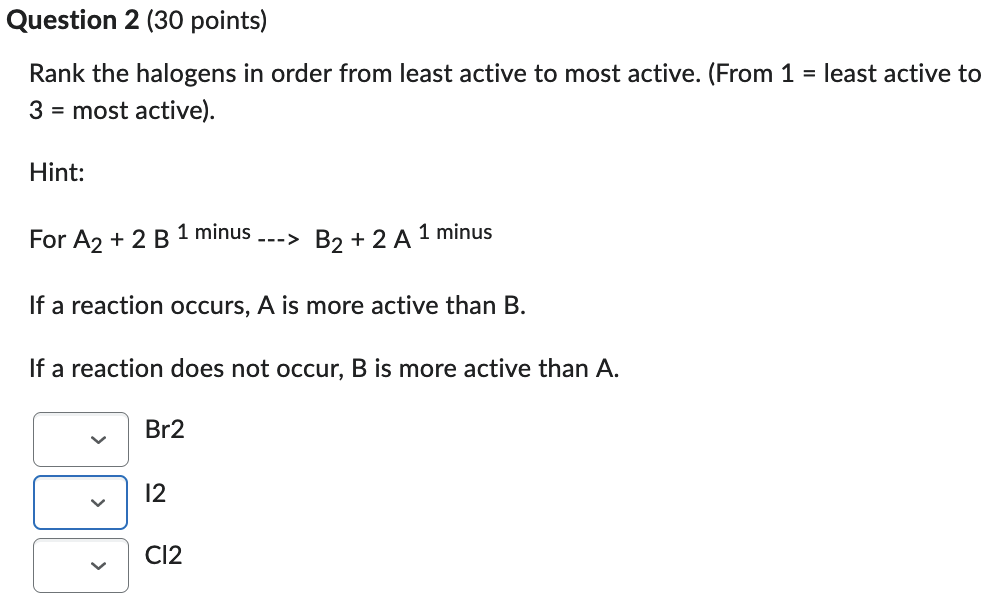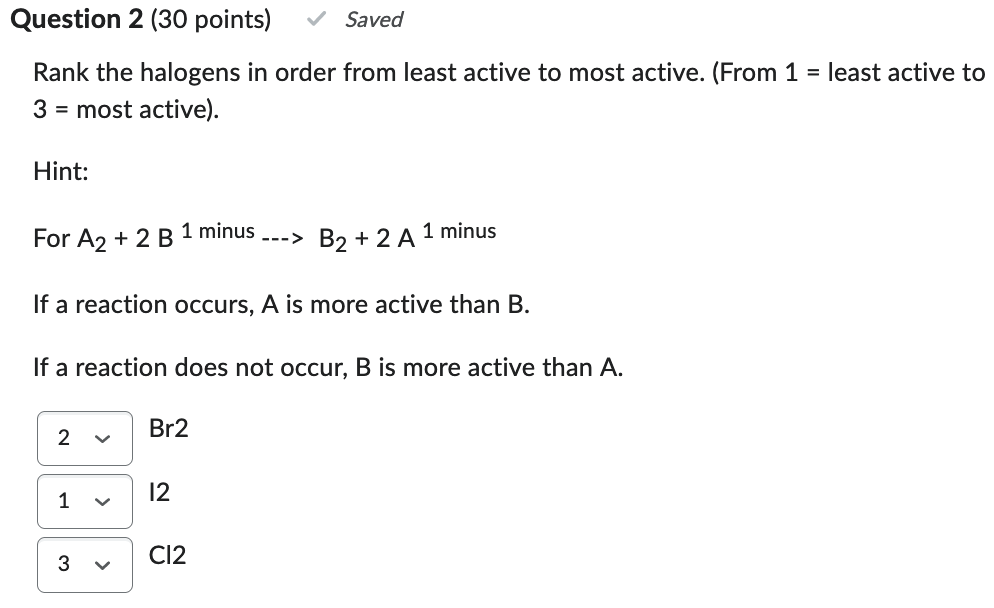
What is the order of solubility of the Group II cations (from 1 = most soluble to 4 = least soluble)?

Ex. By Aarthika on Brainly, https://brainly.com/question/31490709
The order of solubility of Group II cations (from 1= most soluble to 4= least soluble) is as follows:
1. Magnesium (Mg)
2. Calcium (Ca)
3. Strontium
(Sr)
4. Barium (Ba)
To determine the order of solubility of Group II cations (from 1=
most soluble to 4= least soluble), we need to consider the following:
Group II cations typically include Beryllium (Be),
Magnesium (Mg), Calcium (Ca), Strontium (Sr), and Barium (Ba).
However, since you've asked for 4 cations, I'll consider the four most
common ones: Mg, Ca, Sr, and Ba.
The order of solubility of Group II cations,
from most soluble (1) to least soluble (4), can be determined based on
the solubility of their sulfates, which generally decrease down the
group. Here's the order:
1. Magnesium (Mg) - most soluble
2. Calcium (Ca)
3.
Strontium (Sr)
4. Barium (Ba) - least soluble
Keep in mind that this order is based on the solubility of their
sulfates, and the solubility may vary for other compounds formed by
these cations.
Learn more about solubility at brainly.com/question/9098308
#SPJ11

Rank the halogens in order from least active to most active. (From 1 = least active to 3 = most active).
Hint:
For A2 + 2 B 1 minus ---> B2 + 2 A 1 minus
If a reaction occurs, A is more active than B.
If a reaction does not occur, B is more active than A.

Ex. By SadieSharoff12 on Brainly, https://brainly.com/question/37773327
The halogens can be ranked in order of reactivity from least active to most active as: Iodine (I₂), Bromine (Br₂), and Chlorine (Cl₂). Reactivity decreases as you go down the periodic table, due to increased atomic radius and shielding effect.
Explanation:
In the halogen group, reactivity decreases as you move down the group or from top to bottom on the periodic table. This is due to the increase in atomic radius and shielding effect which increases with the increase in atomic number.
Based on their position in the Periodic Table, the halogens can be ranked in order of reactivity from least to most active: Iodine (I₂), Bromine (Br₂), and then Chlorine (Cl₂). So, if we were to assign them ranks:
- Iodine (I₂) would rank 1st, as the least active
- Bromine (Br₂) would rank 2nd
- Chlorine (Cl₂), being the most active, would rank 3rd
Learn more about Halogens Reactivity here:
brainly.com/question/33512974
#SPJ11
Unknown number?
1
Describe in detail how you determined the identity of your unknown cation. State observations for reaction of your unknown with EACH of sulfate, carbonate, oxalate and iodate. Compare these results to the known cations. Which specific cation result matches yours, and state the observations for that cation?
To determine the unknown cation, me and my partner went up to the fume hood and put Ba^2+, Ca^2+, Mg^2+, Sr^2+, and the unknown into each of the cell plates from left to right, filling four of them up to half-full for each. Ba^2+ on the first row, Ca^2+ on the second row, Mg^2+ on the third row, Sr^2+ on the fourth row, and the unknown on the fifth row. After, we added in a couple of drops of SO4^2- to the first column, CO3^2- to the second column, C2O4^2- to the third column, and IO3^- to the fourth row, filling up the five rows we put Ba^2+, Ca^2+, Mg^2+, Sr^2+, and the unknown in. To see a clearer observation of a precipitate, we added a few more drops into the one with Ba^2+ and IO3^-.
For our observation of Ba^2+ and SO4^2-, Ba^2+ and CO3^2-, Ba^2+ and C2O4^2-, and Ba^2+ and IO3^-, we saw a precipitate.
For our observation of Ca^2+ and CO3^2-, and Ca^2+ and C2O4^2-, we saw a precipitate. However, for Ca^2+ and SO4^2- and Ca^2+ and IO3^-, we did not see a reaction.
For our observation of Mg^2+ and CO3^2-, we saw a precipitate. However, for Mg^2+ and SO4^2-, Mg^2+ and C2O4^2-, and Mg^2+ and IO3^-, we did not see a reaction.
For our observation of Sr^2+ and SO4^2-, Sr^2+ and CO3^2-, Sr^2+ and C2O4^2-, we saw a precipitate. However, for and Sr^2+ and IO3^-, we did not see a reaction.
For our observation of unknown and SO4^2-, unknown and CO3^2-, and unknown and C2O4^2-, we saw a precipitate. However, for unknown and IO3^-, we did not see a reaction.
Comparing our results to the known cations, Sr^2+ matches the unknown. For this cation, we saw a precipitate for Sr^2+ and SO4^2-, Sr^2+ and CO3^2-, Sr^2+ and C2O4^2-, and no reaction for Sr^2+ and IO3^-.
What is the identity of the Group II cation in your unknown?
Sr^2+
Describe in detail how you determined the identity of your unknown anion. What specific compounds did you react with your unknown, and what observations did you make? Which specific anion result matches yours, and state the observations for that anion?
To determine the identity of our unknown anion, me and my partner watched the provided YouTube video. However, if we were to do it in person, we would put two full droppers of Br2, Cl2, and I2 into each of the three test tubes. We would then put one to two full droppers of hexane into each of those three test tubes, put the caps on the test tubes, shake each, and then observe the top layers of each for a color change. For the results, we observed that Br2 in hexane turned a orange/red, Cl2 in hexane turned a pale yellow, and I2 in hexane turned a pink. After getting the color results, we would start the halogen with halides tests. We would put two full droppers of Br2, Cl2, I2, and our unknown into each of the four test tubes. Next adding Br^-, Cl^-, and I^- into each of the four test tubes, however, not putting Br^-for Br2, Cl^- for Cl2, and I^- for I2. Then adding one to two full droppers of the hexane layer into each, putting the stopper caps on and shaking each. We would then observe the top layers for each test tube.
For our observation of Br^- and Cl2, we saw an orange color and for our Br^- and I2, we saw a pink/purple color.
For our observation of Cl^- and Br2, we saw an orange/red color and for our Cl^- and I2, we saw a light pink.
For our observation of I^- and Br2, we saw a pink/purple color and for our I^- and Cl2, we saw a pink/purple.
For our observation of X^- and Br2, we saw an orange color, for our X^- and Cl2, we saw an orange color, and for our X^- and I2, we saw a pink/purple color.
Comparing our results to the known anion, Br^- matches the unknown. For this anion, we saw an orange color for Cl^- and Br2, and a pink/purple for Br^- and I2.
What is the identity of the anion in your unknown?
Br^-
What is the total chemical formula of your unknown?
SrBr2
Your instructor will give you instructions as what to do with this box. It may be used for bonus points, or for taking away points (for example late submissions) or for error analysis if something went wrong during the lab. If no instructions have been provided to you, please leave this box blank.
5% = 7.5
...